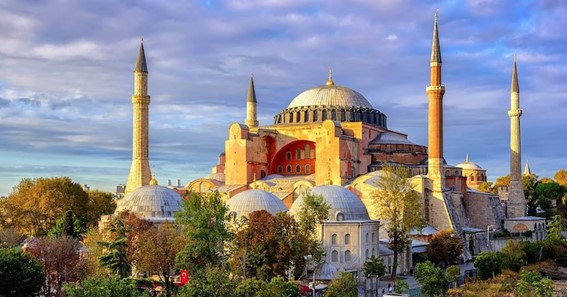Hagia Sophia, located in Istanbul, Turkey, is a historic building that has served as a church, mosque, and museum. Its rich history and stunning architecture make it one of the most visited tourist attractions in Turkey.
The Hagia Sophia was originally built in 537 CE as an Eastern Orthodox cathedral during the reign of Emperor Justinian I. It was considered one of the greatest architectural achievements of its time and was the largest cathedral in the world until the Seville Cathedral was completed in 1520.
For almost 1,000 years, the Hagia Sophia served as the principal church of the Eastern Orthodox Church. It also played an important role in the Byzantine Empire as the site of imperial ceremonies and coronations.
Click here – Rome Attraction Tickets and Places to Visit in Rome
In 1453, after the Ottoman Empire conquered Constantinople (now Istanbul), the Hagia Sophia was converted into a mosque. The Ottomans added minarets, a mihrab, and a pulpit, as well as covering many of the Christian mosaics and frescoes with plaster.
The Hagia Sophia remained a mosque for nearly 500 years, until the founding of the Republic of Turkey in 1935. At that time, the Hagia Sophia was converted into a museum by Mustafa Kemal Atatürk, the first president of Turkey.
The Hagia Sophia museum served as a symbol of Turkey’s secularism and its commitment to preserving the country’s cultural heritage. Visitors from around the world came to see the building’s magnificent architecture and the Christian and Islamic art that had been preserved within its walls.
However, in 2020, Turkish President Recep Tayyip Erdogan announced that the Hagia Sophia would be converted back into a mosque. The decision was met with both criticism and support, with some arguing that it was an important move to reassert Turkey’s Islamic identity, while others argued that it was a blow to Turkey’s secularism and cultural heritage.
The conversion of the Hagia Sophia back into a mosque involved the removal of the museum displays and the reopening of the mihrab and minbar, which had been covered up during the building’s time as a museum. The Christian mosaics and frescoes were not removed but were instead covered with curtains during prayer times.
The decision to convert the Hagia Sophia back into a mosque has been controversial, with many people arguing that it represents a step backwards for Turkey’s secularism and a loss for the preservation of the building’s cultural heritage.
However, others see the conversion as a way to reconnect with Turkey’s Islamic roots and to honor the building’s history as a Hagia Sophia mosque. For many Muslims, the Hagia Sophia holds great religious significance and is seen as an important symbol of Islamic conquest.
Regardless of the controversy, the Hagia Sophia remains an important landmark and a testament to the cultural richness and complexity of Istanbul and Turkey. Its architecture and art reflect the many different influences and cultures that have shaped the region over the centuries.
Visitors to the Hagia Sophia today can still see the building’s magnificent dome, which rises over 50 meters above the ground. They can also see the Christian mosaics and frescoes that have been uncovered and restored in recent years, as well as the Islamic calligraphy and decorations that were added during the building’s time as a mosque.
Whether as a mosque or a museum, the Hagia Sophia is a unique and awe-inspiring testament to the richness and complexity of Turkey’s cultural heritage. Its continued presence and significance serve as a reminder of the many different traditions and influences that have come together to shape the country and its people.






